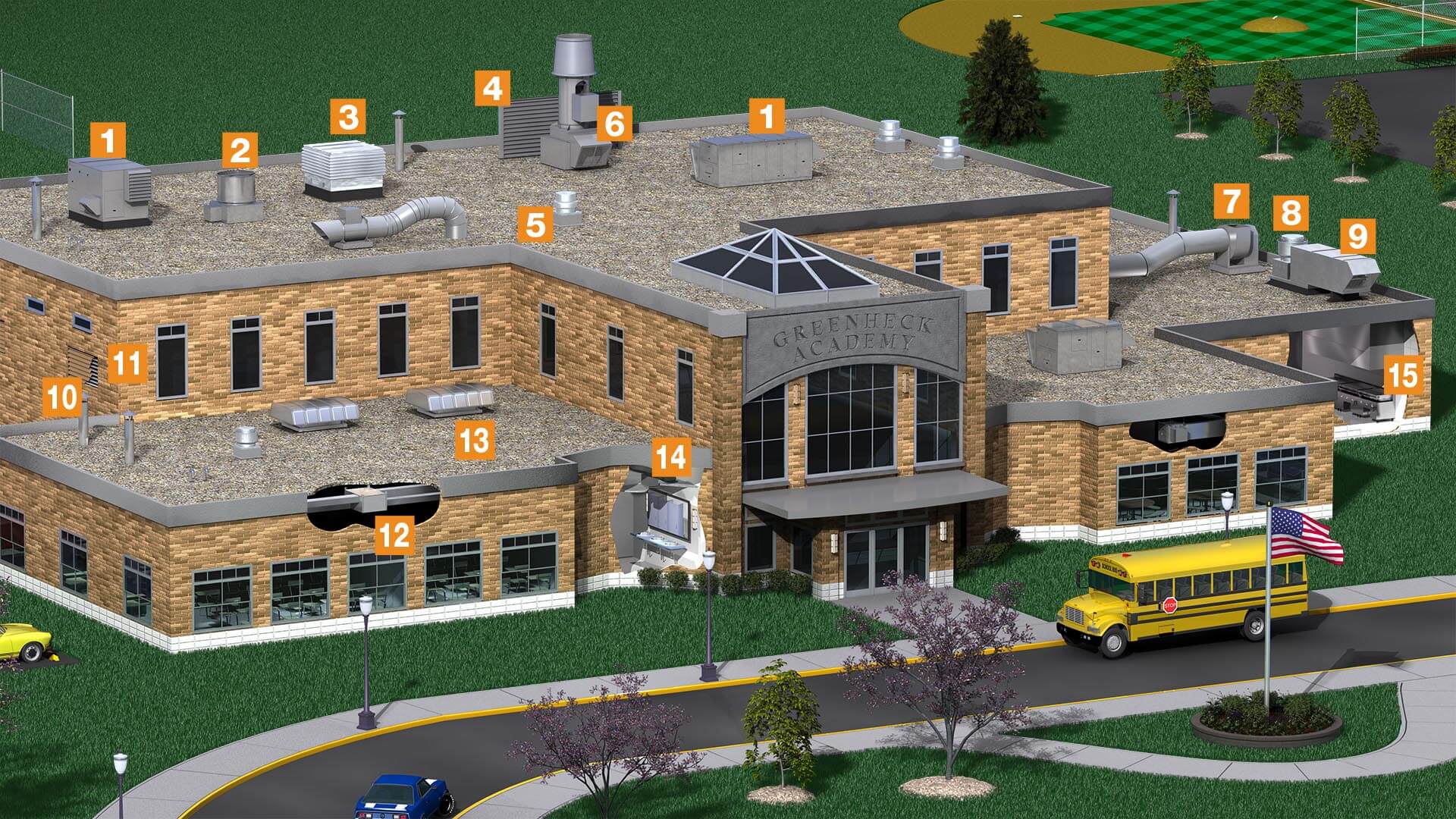HVAC Ventilation Solutions for K-12 Schools

Proper ventilation is crucial to control indoor air quality, temperature, humidity, and air motion to maximize occupant comfort in your space. And now is the perfect time to make sure you’re all set up with the most effective ventilation system for your building. Staff and students are slowly returning to classrooms, and that means the indoor air quality in schools is more important than ever before. As school air control experts, Greenheck offers a variety of solutions to help ensure that your school is ready to have staff and students back full time again, comfortably and safely!
Still not certain if now is the right time to install or upgrade your ventilation system? The CARES Act, as well as the newest $1.9 trillion stimulus package (American Rescue Plan), may change your mind. With the American Rescue Plan, $168 billion is being specifically dedicated to K-12 schools and higher education. This funding can be used for a variety of things, but the one that stuck out to us the most, “Repairing school facilities, especially ventilation systems, to improve air quality and reduce spread of Covid.”
Here are 15 ventilation products you might consider for your school:
- Dedicated Outdoor Air Systems (DOAS): A dedicated outdoor air system (DOAS) is a unit supplying cooled, dehumidified outside air to the building in summer and heated outside air in the winter.
- Axial Upblast Exhaust Fans: Axial fans are a cost-effective option for low to medium pressure applications. Roof-mounted models are designed to discharge clean air or fume exhaust up and away from the building.
- Centrifugal Supply Fans: Centrifugal roof supply fans include filtered and non-filtered belt-driven units. These fans are suitable for non-tempered kitchen make-up air or building supply air.
- Equipment Screens: Building aesthetics are important. Equipment screens hide equipment while providing protective barriers.
- Centrifugal Downblast Exhaust Fans: Roof-mounted centrifugal downblast exhaust fans include direct- and belt-driven fans. These models have backward-inclined centrifugal wheels. These fans are suitable for applications exhausting relatively clean air.
- Laboratory Exhaust Fans: The main objectives of a laboratory exhaust system are removing hazardous or noxious fumes, diluting the fumes, and expelling them at high velocity from the building to minimize the possibility of roof area contamination or re-entrainment into the building make-up air system.
- Utility Sets: Centrifugal utility blowers handle light-duty air applications (indoor, outdoor, supply or exhaust) for commercial or institutional. Units have many discharge configurations, which allow different airflow direction without system losses from duct turns.
- Centrifugal Upblast Exhaust Fans: The centrifugal roof-mounted upblast exhaust fans include both direct and belt drive options with efficient backward-inclined centrifugal wheels and aerodynamic inlet cone minimizing system effects. The motors on the fans are out of the airstream.
- Make-up Air: Select from a variety of make-up air units for commercial, industrial and kitchen applications. Heating options include direct gas-fired, indirect gas-fired, steam, hot water and electric resistance. Available cooling options are evaporative cooling, direct expansion coils and chilled water coils.
- Louver: Greenheck louvers are available in endless standard configurations. Each meets or exceeds the industry’s most stringent test performance standards and provide exceptional aesthetic appeal.
- Control Dampers: Control dampers regulate the flow of air in an HVAC system for intake, exhaust, or mixed air applications. ASHRAE Standard 90.1, California Title 24, and International Energy Conservation Code (IECC) are the three main energy codes relating to dampers. All volume control dampers in this section meet these requirements.
- Square Centrifugal Fans: Square centrifugal inline fans include both direct- and belt-driven fans with backward-inclined or forward-curved wheels. Models feature rugged constructions, high-efficiency, and low sound levels.
- Gravity Ventilators: The gravity intake and relief ventilators are non-powered (do not have a fan) and work on pressure differential between the inside and outside of the building.
- Ceiling Exhaust Fans: The ceiling and cabinet fans are direct drive models that have forward-curved wheels for low sound and high efficiency. These are suitable for clean air applications, such as bathroom, storage room, or office exhaust fans.
- Kitchen Exhaust Hoods: Providing a total kitchen ventilation solution for any commercial kitchen application including restaurants, industrial cooking process, school cafeteria and similar commercial kitchen settings. This includes exhaust hoods for applications such as grease, heat and condensate and institutional residential.
These ventilation products from Greenheck are all great solutions to improving indoor air quality and occupant comfort in your building. Make sure your school is set up for success with the proper ventilation system. Employee, students, and parents will all thank you!
For any additional questions or to talk about the best ventilation options for your school, please contact your local Greenheck representative.
Blog image and source: Greenheck
// about the author

 Hoffman & Hoffman Marketing
Hoffman & Hoffman Marketing
The marketing department at Hoffman & Hoffman is focused on communicating different commercial HVAC solutions to the industry. We often share manufacturer information to help engineers, contractors, and building owners make informed decisions.












